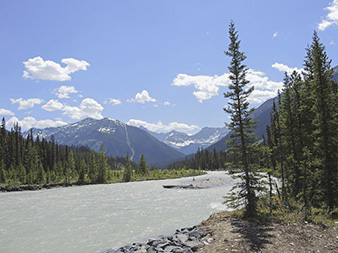
Wildflower vista, Southern Rockies

Aquilegia coerulea (Colorado blue columbine), Herman Gulch, Colorado
Wildflowers of the Rocky Mountain Region
Denver Botanic Gardens
Timber Press Field Guide
This book is dedicated to Loraine Yeatts and Janet Wingate for their decades of contributions to botany in the Rocky Mountain region and service to Denver Botanic Gardens.
Contents








Foreword
The Encyclopedia Britannica lists the Rocky Mountains as number one of the seven great mountain ranges on Earth, followed by the Alps, Atlas Mountains, Himalayas, Andes, Ethiopian Highlands, and Australias Great Dividing Range. Made up of more than 100 separate mountain ranges spreading from Alberta and British Columbia in the north to New Mexico in the south, the Rocky Mountains are a massive cordillera inspiring everyone from mountain climbers, hikers, skiers, and explorers to songwriters like John Denver. In the contiguous United States, Colorado has the highest number (53) of fourteeners (mountain peaks with an elevation of at least 14,000 feet); climbing them all is a popular activity by peak baggers. In addition, the multitude of wildflowers that bloom throughout the season attracts many visitors; a favorite annual event is the Wildflower Festival at Crested Butte in Colorado.
With so many wildflower books on the market, why another one? Almost all the wildflower books currently available are specific to a particular region and mostly separate the Canadian and the U.S. Rockies. This book covers the entire Rocky Mountain range from Canada, south to New Mexico, separated into three main regions: the Northern Rockies, the Middle Rockies, and the Southern Rockies. Within these regions are numerous habitats harboring a diversity of plants. This Timber Press publication was conceived to satisfy the need for a handy guide with photos that will make the plants easy to identify in the field and maps showing the locations where one could encounter them.
This book is a work of passion developed over a period of three years by and supported by years of experience from numerous plant and horticulture experts at Denver Botanic Gardens. Countless hours were spent poring over plant lists and finally narrowing the list down to 1,200 plants that a hiker or visitor in the Rocky Mountains is likely to encounter. Then came the photographs. Many of the authors took special trips to various sites to capture plants in their peak blooming stage. Then came the writing of plant descriptions and sorting thousands of photos, followed by incorporating the maps. I hope you will find this book useful in helping you identify plants on a hike in the magnificent Rocky Mountains and expand your knowledge about the wildflowers and the various habitats they grow in. I also hope you will enjoy the book as much as we have enjoyed putting it together.
Sarada Krishnan, Ph.D.
Director of Horticulture and Center for Global Initiatives
Denver Botanic Gardens

Independence Pass, Colorado

Kootenay Rockies, British Columbia

ArizonaNew Mexico Plateau
Acknowledgments
Wildflowers of the Rocky Mountain Region owes its success to the support, time, expertise, and patience of many people.
A special thank-you is due to Savannah Putnam, who started as an intern to provide additional help with the book but quickly turned into a true project manager; Savannah managed all aspects of the project including keeping ten people on track with photographing, chasing down photos, researching, and writing. She was truly a force of nature, managing the project with a level of grace and competence that few could muster.
Thank you also to our families and friends for being supportive of our extra work in the field photographing plants, long days in the office, evenings of researching and writing, and for listening to our many updates on the current status of the book.
Thank you to the editors and staff at Timber Press, who helped us with every step and allowed us more time to create a more comprehensive field guide.
We would like to thank those who have come before us in writing floras and field guides of this vast and floristically diverse region. Their important contributions were foundational for this project. Much work remains to sort out some taxonomic ambiguities, and the region continues to surprise with new records and species.
Thank you to the National Science Foundation for supporting the digitization of data, creation of websites, and funding of scientific research of plants all over the globe.
A multitude of individuals generously shared their photos, and without them this book would not have been possible. Thank you Adam Burch, Al Schneider, Alan Schroder, Amy Taylor, Ann DeBolt, Barry Breckling, Ben Legler, Bryan Hobby, Christopher Christie, Curtis Bjrk, Emily Kachergis, Ernie Marx, Frank Morrey, Gary A. Monroe, Gary Waggoner, Gerald and Buff Corsi, Ginny Maffitt, Jant Bare, Jay Lunn, Jean Pawek, Jeff Thompson, Jim Pisarowicz, Jo Panosky, Johan Nilsson, Karen Vail, Keir Morse, Linda Vaxvick, Loraine Yeatts, Lori Skulski, Mary Winter, Max Licher, Mike Ireland, Mikel R. Stevens, Neide Bollinger, Pam Eveleigh, Phyllis Weyand, RT Hawke, Sharon Chester, Suzanne Putnam, Todd Boland, Tom Zeiner, and William Adams.
In addition to contributing photos, the following individuals and organizations provided advice and information for which we are eternally grateful: Curtis Bjrk, Phyllis Gustafson (Wildflowers of the Pacific Northwest), Pam Eveleigh (Primula World), Loraine Yeatts, Janet Wingate (Denver Botanic Gardens Kathryn Kalmbach Herbarium), Bonnie Heidel (University of Wyoming), Al Schneider ( swcoloradowildflowers.com ), Ernie Marx (Eastern Colorado Wildflowers), Scott Smith, Karen Vail (Yampatika, Steamboat Springs, CO), John T. Kartesz (Biota of North America Program), Ann DeBolt, Roger Rosentreter, Jennifer Ackerfield (Colorado State University Herbarium and
Next page















